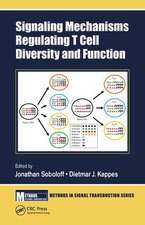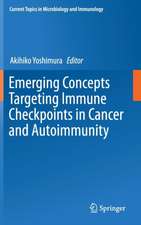Advances in Host-Directed Therapies Against Tuberculosis
Editat de Petros C. Karakousis, Richard Hafner, Maria Laura Gennaroen Limba Engleză Paperback – 3 dec 2021
| Toate formatele și edițiile | Preț | Express |
|---|---|---|
| Paperback (1) | 1412.43 lei 6-8 săpt. | |
| Springer International Publishing – 3 dec 2021 | 1412.43 lei 6-8 săpt. | |
| Hardback (1) | 1419.56 lei 6-8 săpt. | |
| Springer International Publishing – 3 dec 2020 | 1419.56 lei 6-8 săpt. |
Preț: 1412.43 lei
Preț vechi: 1486.77 lei
-5% Nou
Puncte Express: 2119
Preț estimativ în valută:
270.30€ • 281.16$ • 223.15£
270.30€ • 281.16$ • 223.15£
Carte tipărită la comandă
Livrare economică 14-28 aprilie
Preluare comenzi: 021 569.72.76
Specificații
ISBN-13: 9783030569075
ISBN-10: 3030569071
Ilustrații: XIII, 332 p. 20 illus.
Dimensiuni: 155 x 235 mm
Greutate: 0.49 kg
Ediția:1st ed. 2021
Editura: Springer International Publishing
Colecția Springer
Locul publicării:Cham, Switzerland
ISBN-10: 3030569071
Ilustrații: XIII, 332 p. 20 illus.
Dimensiuni: 155 x 235 mm
Greutate: 0.49 kg
Ediția:1st ed. 2021
Editura: Springer International Publishing
Colecția Springer
Locul publicării:Cham, Switzerland
Cuprins
Section 1: Introduction
Chapter 1: Introduction: An overview of host-directed therapies for tuberculosis
Daniel Frank, Robert Mahon
Section 2: Targeting immunometabolism
Chapter 2: Sirtuin deacetylases: Linking Mycobacterial infection and host metabolism
Lorissa Smulan, Hardy Kornfeld, and Amit Singhal
Chapter 3: The mammalian target of rapamycin complex 1 (mTORC1): an ally of M. tuberculosis in host cells
Natalie Bruiners, Valentina Guerrini, Maria Laura Gennaro
Chapter 4: HIF-1α as a potential therapeutic target for tuberculosis treatment
Qingkui Jiang, Maria Laura Gennaro, Lanbo Shi
Chapter 5: Nuclear receptors in host-directed therapies against tuberculosis
Eun-Kyeong Jo
Section 3: Enhancing anti-mycobacterial mechanisms
Chapter 6: Autophagy as a target for host-directed therapy against tuberculosis
Surbhi Verma, Raman Deep Sharma and Dhiraj Kumar
Chapter 7: Metformin: a leading HDT candidate for TB
Amit Singhal and Hardy Kornfeld
Chapter 8: Statins as host-directed therapy for tuberculosis
Noton K. Dutta, Petros C. Karakousis
Chapter 9: Antimycobacterial attributes of mitochondria: An insight into host defense mechanisms
Rikesh K Dubey, Apoorva Narain
Section 4: Targeting immune cells
Chapter 10: Conventional and unconventional lymphocytes in immunity against Mycobacterium tuberculosis
Paula Ruibal, Tom H.M. Ottenhoff, Simone A. Joosten
Chapter 11: Targeting inhibitory cells such as Tregs and MDSCs in the tuberculous granuloma
Sadiya Parveen, John R. Murphy, and William R. Bishai
Chapter 12: Targeting suppressor T cells
Léanie Kleynhans, Gerhard Walzl
Chapter 13: Neutrophil-mediated mechanisms as targets for host-directed therapies against tuberculosis
Tobias Dallenga, Ulrich E. Schaible
Chapter 14: Type I interferon and interleukin-1 driven inflammatory pathways as targets for HDT in tuberculosis
Katrin D. Mayer-Barber, Christopher M. Sassetti
Chapter 15: Mucosal-associated invariant and Vγ9Vδ2 T cells
Charles K. Vorkas, Michael S. Glickman
Chapter 16: Airway epithelial cells
Angélica M. Olmo-Fontánez, Jordi B. Torrelles
Section 5: Preclinical models for assessing HDTs
Chapter 17: In vitro models of human granuloma formation to analyze host-directed therapies
Liku B. Tezera, Michaela T. Reichmann, Basim Al Shammari, Paul T. Elkington
Chapter 18: C3HeB/FeJ as a key mouse strain for testing host-directed therapies against tuberculosis
Pere-Joan Cardona, Cristina Vilaplana
Chapter 19: The Rabbit Model for Assessing Host-Directed Therapies for Tuberculosis
Selvakumar Subbian, Gilla Kaplan
Section 6: Clinical trials of HDTs and special considerations for study endpoints
Chapter 20: Clinical trials of TB-HDT candidates
Robert S. WallisChapter 21: Outcomes for clinical trials of host-directed therapies for tuberculosis
Akshay N. Gupte, Sara C. Auld, William N. Checkley, Gregory P. Bisson
Chapter 22: Pharmacological considerations for clinical trials of host-directed therapies for tuberculosis
Elisa H. Ignatius, Kelly E. Dooley
Chapter 1: Introduction: An overview of host-directed therapies for tuberculosis
Daniel Frank, Robert Mahon
Section 2: Targeting immunometabolism
Chapter 2: Sirtuin deacetylases: Linking Mycobacterial infection and host metabolism
Lorissa Smulan, Hardy Kornfeld, and Amit Singhal
Chapter 3: The mammalian target of rapamycin complex 1 (mTORC1): an ally of M. tuberculosis in host cells
Natalie Bruiners, Valentina Guerrini, Maria Laura Gennaro
Chapter 4: HIF-1α as a potential therapeutic target for tuberculosis treatment
Qingkui Jiang, Maria Laura Gennaro, Lanbo Shi
Chapter 5: Nuclear receptors in host-directed therapies against tuberculosis
Eun-Kyeong Jo
Section 3: Enhancing anti-mycobacterial mechanisms
Chapter 6: Autophagy as a target for host-directed therapy against tuberculosis
Surbhi Verma, Raman Deep Sharma and Dhiraj Kumar
Chapter 7: Metformin: a leading HDT candidate for TB
Amit Singhal and Hardy Kornfeld
Chapter 8: Statins as host-directed therapy for tuberculosis
Noton K. Dutta, Petros C. Karakousis
Chapter 9: Antimycobacterial attributes of mitochondria: An insight into host defense mechanisms
Rikesh K Dubey, Apoorva Narain
Section 4: Targeting immune cells
Chapter 10: Conventional and unconventional lymphocytes in immunity against Mycobacterium tuberculosis
Paula Ruibal, Tom H.M. Ottenhoff, Simone A. Joosten
Chapter 11: Targeting inhibitory cells such as Tregs and MDSCs in the tuberculous granuloma
Sadiya Parveen, John R. Murphy, and William R. Bishai
Chapter 12: Targeting suppressor T cells
Léanie Kleynhans, Gerhard Walzl
Chapter 13: Neutrophil-mediated mechanisms as targets for host-directed therapies against tuberculosis
Tobias Dallenga, Ulrich E. Schaible
Chapter 14: Type I interferon and interleukin-1 driven inflammatory pathways as targets for HDT in tuberculosis
Katrin D. Mayer-Barber, Christopher M. Sassetti
Chapter 15: Mucosal-associated invariant and Vγ9Vδ2 T cells
Charles K. Vorkas, Michael S. Glickman
Chapter 16: Airway epithelial cells
Angélica M. Olmo-Fontánez, Jordi B. Torrelles
Section 5: Preclinical models for assessing HDTs
Chapter 17: In vitro models of human granuloma formation to analyze host-directed therapies
Liku B. Tezera, Michaela T. Reichmann, Basim Al Shammari, Paul T. Elkington
Chapter 18: C3HeB/FeJ as a key mouse strain for testing host-directed therapies against tuberculosis
Pere-Joan Cardona, Cristina Vilaplana
Chapter 19: The Rabbit Model for Assessing Host-Directed Therapies for Tuberculosis
Selvakumar Subbian, Gilla Kaplan
Section 6: Clinical trials of HDTs and special considerations for study endpoints
Chapter 20: Clinical trials of TB-HDT candidates
Robert S. WallisChapter 21: Outcomes for clinical trials of host-directed therapies for tuberculosis
Akshay N. Gupte, Sara C. Auld, William N. Checkley, Gregory P. Bisson
Chapter 22: Pharmacological considerations for clinical trials of host-directed therapies for tuberculosis
Elisa H. Ignatius, Kelly E. Dooley
Notă biografică
Petros C. Karakousis, M.D., is an infectious diseases-trained physician scientist and Professor of Medicine at the Johns Hopkins University School of Medicine. His research focus is on host-pathogen interactions contributing to Mycobacterium tuberculosis persistence and antibiotic tolerance. His laboratory is actively investigating the repurposing of clinically available agents with immune-modulatory properties as adjunctive host-directed therapy, in order to shorten the duration of TB treatment and improve lung pathology.
Maria Laura Gennaro, M.D., is Professor of Medicine at Rutgers New Jersey School of Medicine. Her laboratory studies mechanisms of adaptation expressed by Mycobacterium tuberculosis and by the host macrophage during infection, with the goal of finding targets for therapeutic intervention. She has a specific interest in macrophage lipid metabolism, which is altered following M. tuberculosis infection, thereby promoting bacterial survival.
Richard Hafner, M.D., is an infectious diseases-trained physician and Chief of the TB Clinical Research Branch in the Division of AIDS at NIAID/NIH. Throughout his career, he has had a long-standing interest in advancing innovative host-directed therapies for infections. He has been involved in several clinical trials, authored various articles, and hosted multiple scientific meetings related to research to develop targeted HDTs for TB.
Maria Laura Gennaro, M.D., is Professor of Medicine at Rutgers New Jersey School of Medicine. Her laboratory studies mechanisms of adaptation expressed by Mycobacterium tuberculosis and by the host macrophage during infection, with the goal of finding targets for therapeutic intervention. She has a specific interest in macrophage lipid metabolism, which is altered following M. tuberculosis infection, thereby promoting bacterial survival.
Richard Hafner, M.D., is an infectious diseases-trained physician and Chief of the TB Clinical Research Branch in the Division of AIDS at NIAID/NIH. Throughout his career, he has had a long-standing interest in advancing innovative host-directed therapies for infections. He has been involved in several clinical trials, authored various articles, and hosted multiple scientific meetings related to research to develop targeted HDTs for TB.
Textul de pe ultima copertă
This book discusses specific immune cell regulatory pathway(s), immune cell types, or other mechanisms involved in host responses to tuberculosis that can be potentially targeted for host-directed therapy (HDT). The pathways/mechanisms investigated are either protective – thus calling for pathway/factor enhancing drugs – or maladaptive – thus calling for pathway/factor inhibitory drugs. Discovery and development (pre-clinical and clinical) of candidate HDT agents will also be elucidated, as well as approaches for HDT of other diseases. The benefit to the reader will derive from learning about the biology of multiple host pathways involved in health and disease, how these pathways are disrupted or dysregulated during tuberculosis, and which druggable targets exist in these pathways. This book provides the reader with a roadmap of current and future directions of HDT against tuberculosis. Since the host pathways/factors involved in protective or maladaptive responses to tuberculosis are not disease-specific, information learned from the context of tuberculosis likely will be relevant to other infectious and non-infectious diseases.
Caracteristici
Host-directed therapy is a unique, innovative, and burgeoning new approach for the treatment of infectious diseases, and specifically for tuberculosis, the leading cause of death by a single infectious agent. As a new field, no similar comprehensive survey of completed and ongoing research exists
Each section of the text contains several chapters written by a top expert in that specific area. The information provided represents a thorough and state-of-the-art analysis of the field
The implications for host responses and pathways are of broad interest in physiology and in various diseases of non-infectious origin (e.g, autoimmunity, cancer, metabolic disorders), or those that can be exploited for treating infectious diseases other than tuberculosis
Each section of the text contains several chapters written by a top expert in that specific area. The information provided represents a thorough and state-of-the-art analysis of the field
The implications for host responses and pathways are of broad interest in physiology and in various diseases of non-infectious origin (e.g, autoimmunity, cancer, metabolic disorders), or those that can be exploited for treating infectious diseases other than tuberculosis























